

A history of residential schools in Canada - Canada. What is a residential school?
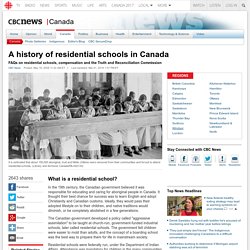
In the 19th century, the Canadian government believed it was responsible for educating and caring for aboriginal people in Canada. It thought their best chance for success was to learn English and adopt Christianity and Canadian customs. Ideally, they would pass their adopted lifestyle on to their children, and native traditions would diminish, or be completely abolished in a few generations. The Canadian government developed a policy called "aggressive assimilation" to be taught at church-run, government-funded industrial schools, later called residential schools.
The government felt children were easier to mold than adults, and the concept of a boarding school was the best way to prepare them for life in mainstream society. Residential schools were federally run, under the Department of Indian Affairs. How many residential schools and students were there? Kid's Biography: Martin Luther King, Jr. History >> Biography >> Civil Rights for Kids Martin Luther King at the March on Washingtonby Unknown Occupation: Civil Rights Leader Born: January 15, 1929 in Atlanta, GA Died: April 4, 1968 in Memphis, TN Best known for: Advancing the Civil Rights Movement and his "I Have a Dream" speechBiography: Martin Luther King, Jr. was a civil rights activist in the 1950s and 1960s.
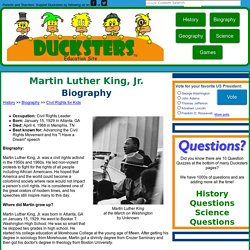
He led non-violent protests to fight for the rights of all people including African Americans. He hoped that America and the world could become a colorblind society where race would not impact a person's civil rights. Where did Martin grow up? Martin Luther King, Jr. was born in Atlanta, GA on January 15, 1929. Martin's dad was a preacher which inspired Martin to pursue the ministry.
Documenting Democracy. Significance This document put in place the law that was the cornerstone of Australia's 'White Australia' policy.
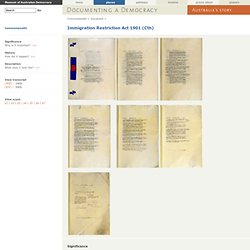
The Universal Declaration of Human Rights. Invisible Australians: Living under the White Australia Policy. What are human rights? Human rights recognise the inherent value of each person, regardless of background, where we live, what we look like, what we think or what we believe.
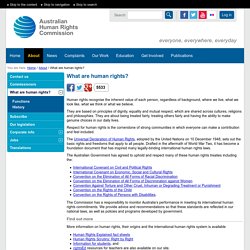
They are based on principles of dignity, equality and mutual respect, which are shared across cultures, religions and philosophies. They are about being treated fairly, treating others fairly and having the ability to make genuine choices in our daily lives. Respect for human rights is the cornerstone of strong communities in which everyone can make a contribution and feel included. "You Don’t Have Rights Here" Commission Website: Information for Students - Human Rights Essentials - Human Rights Timeline. Human rights can be traced back through many centuries of history.
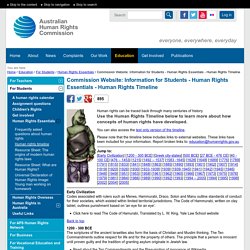
You can also access the text only version of the timeline. Please note that the timeline below includes links to external websites. These links have been included for your information. Report broken links to: education@humanrights.gov.au. The 1950-60's Black Civil Rights Movement in America. The actions of the 1900's black civil rights movement, and a brief outline of the events that occurred.

America is advertised as the world's greatest democracy, the land of freedom and equality. However, as little as 40 years ago this slogan was far from the truth. African-Americans were discriminated against constantly, tortured and killed for no other reason than their skin color. The 1950-60's Black Civil Rights Movement in America. A Century of Racial Segregation 1849–1950 - Brown v. Board at Fifty: "With an Even Hand" An elementary school in Hurlock, Maryland, ca. 1935.
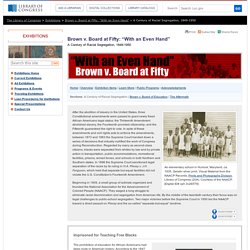
Gelatin silver print. Visual Material from the NAACP Records, Prints and Photographs Division, Library of Congress (20A). Courtesy of the NAACP. [Digital ID# cph 3c26579] We Were There - The Greensboro Sit Ins. Protests of 1968. The protests of 1968 comprised a worldwide escalation of social conflicts, predominantly characterized by popular rebellions against military, capitalist, and bureaucratic elites, who retorted with an escalation of political repression.

In capitalist countries, these protests marked a turning point for the Civil Rights movement in the United States, which produced revolutionary movements like the Black Panther Party. In reaction to the Tet Offensive, protests also sparked a broad movement in opposition to the Vietnam War all over the United States and even into London, Paris, Berlin and Rome. Mass socialist or communist movements grew not only in the United States but also in most European countries. Jim Crow Laws - Separate Is Not Equal.
“Marriages are void when one party is a white person and the other is possessed of one-eighth or more negro, Japanese, or Chinese blood.”

—Nebraska, 1911 “Separate free schools shall be established for the education of children of African descent; and it shall be unlawful for any colored child to attend any white school, or any white child to attend a colored school.” —Missouri, 1929 “All railroads carrying passengers in the state (other than street railroads) shall provide equal but separate accommodations for the white and colored races, by providing two or more passenger cars for each passenger train, or by dividing the cars by a partition, so as to secure separate accommodations.” The KKK and racial problems. The Ku Klux Klan was basically based in the south of America. Here they targeted those set free after the American Civil War - the African Americans. The KKK had never considered the former slaves as being free and terrorised Africa American families based in the South. America experienced great economic prosperity during the 1920's but not much of it filtered to the South.
Racism mixed with anger at their economic plight formed a potent cocktail. Many different groups had emigrated to America over the years. Selma-to-Montgomery March. The Selma-to-Montgomery March for voting rights ended three weeks--and three events--that represented the political and emotional peak of the modern civil rights movement.
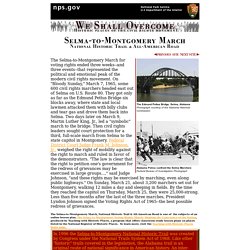
On "Bloody Sunday," March 7, 1965, some 600 civil rights marchers headed east out of Selma on U.S. Route 80. They got only as far as the Edmund Pettus Bridge six blocks away, where state and local lawmen attacked them with billy clubs and tear gas and drove them back into Selma. Two days later on March 9, Martin Luther King, Jr., led a "symbolic" march to the bridge. Then civil rights leaders sought court protection for a third, full-scale march from Selma to the state capitol in Montgomery.
Itinerary Home | List of Sites | Main Map | Learn More | Next Site. Bloody Sunday, Selma, Alabama, (March 7, 1965) Alabama State Troopers Attack John Lewis at the Edmund Pettis Bridge "Image Ownership: Public Domain" Between 1961 and 1964, the Student Nonviolent Coordinating Committee (SNCC) had led a voting registration campaign in Selma, the seat of Dallas County, Alabama, a small town with a record of consistent resistance to black voting. When SNCC’s efforts were frustrated by stiff resistance from the county law enforcement officials, Martin Luther King, Jr. and the Southern Christian Leadership Conference (SCLC) were persuaded by local activists to make Selma’s intransigence to black voting a national concern.
SCLC also hoped to use the momentum of the 1964 Civil Rights Act to win federal protection for a voting rights statute. During January and February, 1965, King and SCLC led a series of demonstrations to the Dallas County Courthouse. “Bloody Sunday” was televised around the world. Ten Things You Should Know About Selma Before You See the Film. In this 50th anniversary year of the Selma-to-Montgomery March and the Voting Rights Act it helped inspire, national media will focus on the iconic images of “Bloody Sunday,” the words of Dr. Martin Luther King Jr., the interracial marchers, and President Lyndon Johnson signing the Voting Rights Act. This version of history, emphasizing a top-down narrative and isolated events, reinforces the master narrative which civil rights activists describe as, “Rosa sat down, Martin stood up, and the white folks came South to save the day.” But there is a “people’s history” of Selma that we all can learn from—one that is needed especially now.
The exclusion of Blacks and other people of color from voting is still a live issue. Sheriff’s deputies may no longer be beating people to keep them from registering to vote, but in 2013 the Supreme Court ruled in Shelby v. The History of Apartheid in South Africa. South Africa (see map) is a country blessed with an abundance of natural resources including fertile farmlands and unique mineral resources. South African mines are world leaders in the production of diamonds and gold as well as strategic metals such as platinum. The climate is mild, reportedly resembling the San Francisco bay area weather more than anywhere in the world. Apartheid. APARTHEID - ARTICLES, VIDEOS, PICTURES & FACTS. In 1976, when thousands of black children in Soweto, a black township outside Johannesburg, demonstrated against the Afrikaans language requirement for black African students, the police opened fire with tear gas and bullets.
The protests and government crackdowns that followed, combined with a national economic recession, drew more international attention to South Africa and shattered all illusions that apartheid had brought peace or prosperity to the nation. Nelson Mandela's Life Story. Apartheid in South Africa. Racial segregation in South Africa began in colonial times under Dutch rule.[6] Apartheid as an official policy was introduced following the general election of 1948.
Documentary Nelson Mandela The Fight For Freedom - Documentary BBC. Racism No Way - Edward Koiki Mabo. Fact sheets Edward Koiki Mabo 1936 - 1992. Eddie Mabo. 1907_ABC1_Education_Schools_Opener_hi.flv. Vincent Lingiari. Vincent Lingiari (1919? The Wave Hill 'walk-off' Wave Hill Station is located approximately 600 kilometres south of Darwin in the Northern Territory. Vincent Lingiari. (c.1908 to 1988) Catherine (Cathy) Freeman. Sir Douglas Ralph (Doug) Nicholls. Charles (Charlie) Perkins. David Unaipon. Albert (Elea) Namatjira. Kenneth Hurtle Wanganeen. Robert Mckenzie Wanganeen. Trugernanner (Truganini) Mullawirraburka. Australia. Ku Klux Klan - Facts & Summary. I Have A Dream Speech (TEXT) Mississippi Burning. The Martin Luther King Story. 1989: Massacre in Tiananmen Square. Origins and consequences of the 1989 Tiananmen Square massacre. Encyclopedia Britannica. American civil rights movement. Slavery: The Abolition of Slavery Project.
The Universal Declaration of Human Rights. Amnesty International. Italian migration to Australia in the 20th century. Mabo/Mabo - The Native Title Revolution. Humanrights.gov. Collaborating for Indigenous Rights 1957-1973. Indigenous rights and freedoms. Rosa Parks - KIDS DISCOVER. Montgomery Bus Boycott. Little Rock Nine. Jim Crow Laws. Slavery in the United States. Civil Rights Act of 1964. African-American Civil Rights Movement.
Rosa Parks Bus - The Story Behind the Bus. On Violence and Nonviolence: The Civil Rights Movement in Mississippi. From NY to Texas, KKK recruits with candies and fliers. Ku Klux Klan. Civil Rights Movement: "Black Power" Era. Brown v. Board. Sources 1960s. GCSE textbook account Voting Rights Act 1965. Rosa Parks. Constitutional Rights Foundation. KS3 Bitesize History - The triangular slave trade : Revision. KS3 Bitesize History - The campaign for women's suffrage : Revision.
KS3 Bitesize History - The civil rights movement in America : Revision. Civil Rights Movement Timeline (14th Amendment, 1964 Act, Human Rights Law) Major Civil Rights Speeches and Writings. Civil Rights Movement Timeline (14th Amendment, 1964 Act, Human Rights Law) New StoryCorps Animated Video On Civil Rights Struggle. LBJ QUOTES about 1964 Act.